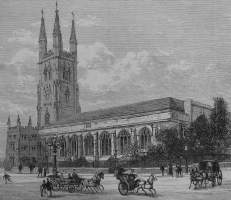 St Sepulchre without Newgate..
St Sepulchre without Newgate..
 St Sepulchre without Newgate..
St Sepulchre without Newgate..
St Sepulchre Holborn is of interest to these pages on sculpture for several 17th century monuments inside, and two works outside. There is a link to St Mary le Bow through John Smith, first Governor of Virginia, and like that church and of no relevance to these pages, it is one of the ‘Oranges and Lemons’ churches (the ‘Bells of Old Bailey’). The full name is the Church of the Holy Sepulchre without Newgate, ‘Sepulchre’ referring to the Church of the Holy Sepulchre in Jerusalem, as the original church on this site was a starting point for knights going on Crusade. ‘Without Newgate' refers to its location just outside the city walls near Newgate, one of the original ancient city gates.
First, the architecture. The bulk of the church is post Fire of London (rebuilt 1670-71), but there are parts dating to a rebuild of the 15th Century by Sir John Popham, former Chancellor of Normandy and Treasurer of the King’s Household in the time of Henry VI. A bust in stone of Popham was above the porch, of which no trace remains, but the porch itself survives. The large South West Tower is also from the 15th Century, but much restored. The little monument – a statue of a boy – marking the end of the Great Fire is just up Giltspur Street, yet St Sepulchre was internally gutted, with only the tower, porch and walls surviving the Fire and Christopher Wren’s rapid rebuild at the beginning of the 1670s, which, however kept the large dimensions of the 15th Century building. After some period of decay, the whole building was resurfaced in Portland Stone in 1790, and a Victorian restoration in 1878-9 by W. P. Griffith and A. Billing saw the addition of the distinctively large pinnacles or corner spires to the tower and much of the 1790 changes reversed – in particular, the semi-circular windows were replaced with proper Perpendicular ones. The engraving below, from the 1820s, shows that the pinnacles are already pretty large before the Victorian renovation. We also see the pre-Victorian round-headed windows, - freshly replaced in the Victorian remodelling at the top of this page. Despite the complete external refacing then, the pinnacles, and the windows being 19th Century, the church may well look rather similar to its 15th Century appearance. But one more point about the engraving below (you will need to click to enlarge) - could the lunette with little blob on the porch be indicative of the bust of Popham?
Inside then. The interior of the porch survives as original 15th Century work, with a fan-vaulted ceiling, and liernes (intermediate architectural ribs) going down to the floor, all excellently medieval. There are carved bosses where the ribs meet – little heraldic shields, heads of angels, roses and so forth.
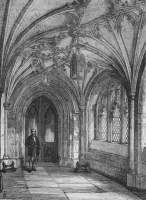 Interior of the 15th Century Porch.
Interior of the 15th Century Porch.
The body of the church, not particularly connected stylistically with the exterior, is large (largest of the City churches) and fairly empty, given its modern use as the national musicians’ church. Putting aside reredos, remnants of organ etc of the 17th Century which are not really the concern of this page, items of sculptural interest include the 1670 font, with carved cherub heads, and a wooden font cover with an angel of 1690 which came from Christ Church Newgate. (That church, originally the Grey Friars (Franciscan monastic order) church, was rebuilt after the Fire by Wren, bombed, and only the tower survives, and ruins of the Nave as a public garden). The north east pillar includes a stone presented in 1964 from the Jerusalem Holy Sepulchre church.
Most of the monuments, on the walls and pillars, are 17th and 18th Century, and as is typical, the sculptors are not identified. We note the following:
More cartouches: Thomas Sawyer, Roger Reeves and Mary Sales.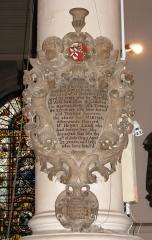
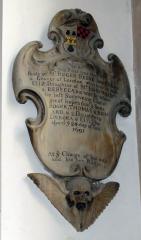
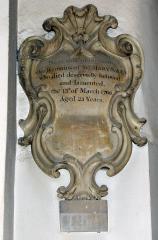
The monument erected to John Smith, first Governor of the Colony of Virginia, USA, is long gone. He is buried in the south aisle, and the lines on the old monument, starting ‘Here lies one conquered that hath conquered kings,// Subdued large territories, and done things// Which to the world impossible would seem…’, are reproduced on a modern plaque. A 1968 stained glass window designed by Francis Skeat also commemorates him. His life was exciting and contains elements of romance, most notably his capture by Indians and help from Princess Pocahontas. The statue of John Smith at St Mary le Bow is shown on this page.
Also buried here, but with no sign of a monument that I saw, we may mention Revd. John Rogers, who enjoys distinction as the first to be burned as a Protestant in the reign of Queen Mary, and the engraver Robert Peake.
As the nearest church to Newgate prison (where Old Bailey now stands with its famous Justice statue, just diagonally across the main road, which is Newgate), it was St Sepulchre’s bells which gave time to the hangman when executions took place. On a board in the church it is recorded that in 1605, ‘Mr Robert Dowe gave, for ringing the greatest bell in this church on the day the condemned prisoners are executed, and for other services, for ever, concerning such condemned prisoners, for which services the sexton is paid £1 6s 8d - £50.’ It is recorded that ‘the charitable Mr Dowe was buried in the church of St Botolph Aldgate’.
The formerly large churchyard has been much reduced; the memorial garden is to the Royal Fusiliers, City of London. On the railings is the very first drinking fountain put up by Gurney for his Metropolitan Drinking Fountain and Cattle Trough Association, removed, then restored to its original placement in 1913. On the exterior wall on the Giltspur Street side is the Charles Lamb monument by William Reynolds-Stephens, a simple bust with stone surround, and note that he was a Bluecoat boy there for 7 years.
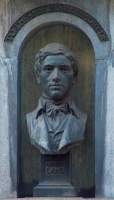 Reynolds-Stephens bust of Charles Lamb.
Reynolds-Stephens bust of Charles Lamb.
Next to the church in Giltspur St is a parish watch house, dated 1791, rebuilt 1962 after being blown up in WW2 (the church itself escaped significant war damage). It may have been to deter corpses from being dug up from the churchyard for anatomical use, conceivably towards the purposes supported by Edward Arris noted above.
Next to the Church used to be the Saracen’s Head inn, one of the oldest in London, removed late in the 19th C. Sculpture was noted on this building by no less a personage than Charles Dickens, who writes in Nicholas Nickleby of ‘its portals guarded by two Saracens’ heads and shoulders… there they are, frowning upon you from each side of the gateway; and the inn itself, garnished with another Saracen’s head, frowns upon you from the top of the yard; while from the door of the hind-boot of all the red coaches that are standing therein, there glares a small Saracen’s head with a twin expression to the large Saracen’s head below, so that the general appearance of the pile is of the Saracenic order.’
With thanks the Church authorities for permission to use pictures of the monuments inside the Church; their website is at http://stsepulchres.org/.
Go across the road to the Old Bailey // or East along Newgate to Christ Church Newgate Street, // South to St Martin's Ludgate
West to Holborn Viaduct // and then the Prince Albert Statue, Holborn Circus // and then the Prudential War Memorial
City Churches // Christopher Wren // London sculpture // Sculptors // Introduction to church monuments
Angel statues // Cherub sculpture
Visits to this page from 4 Jan 2012: 11,325